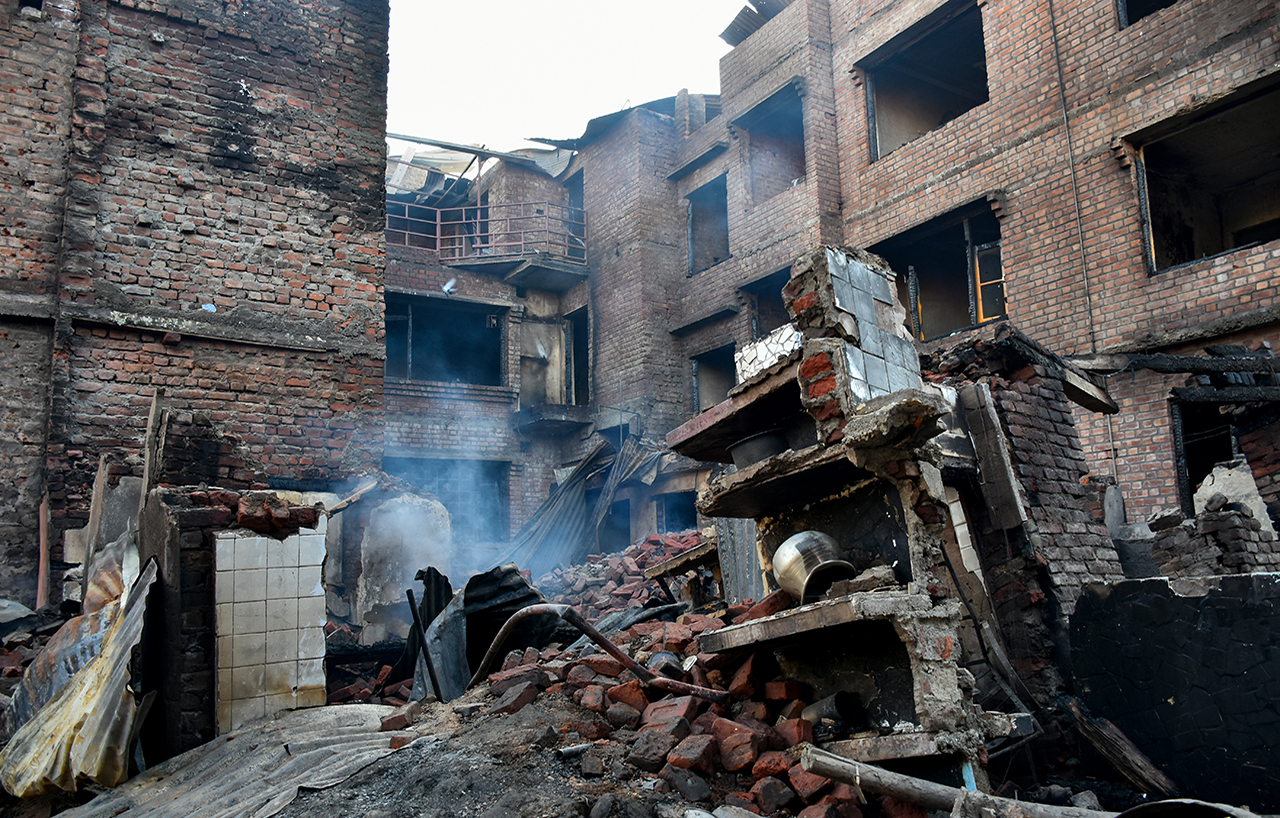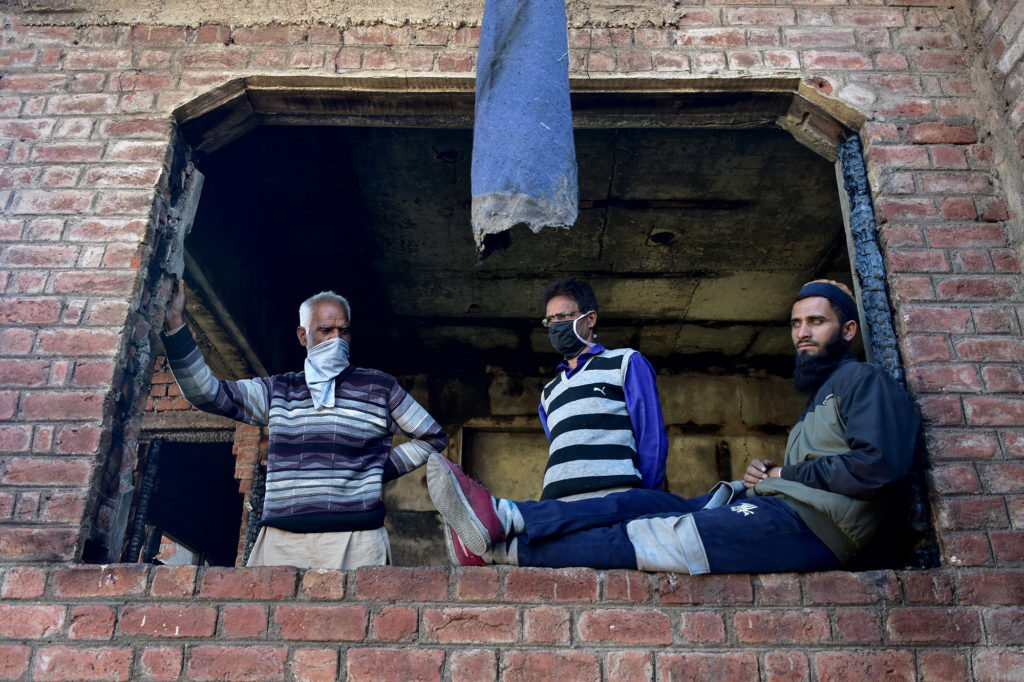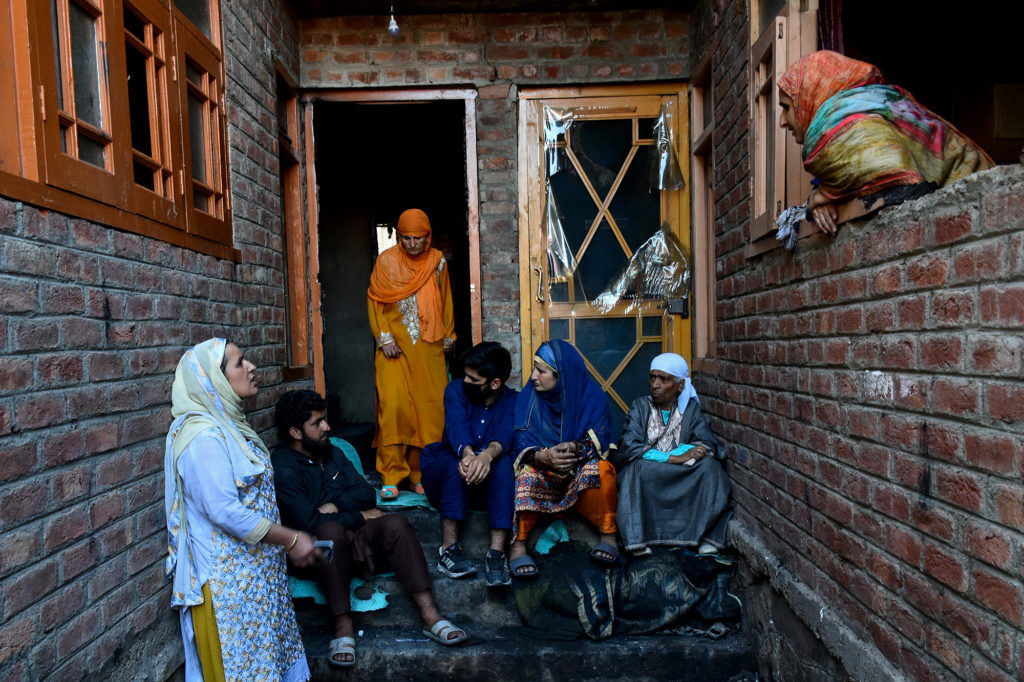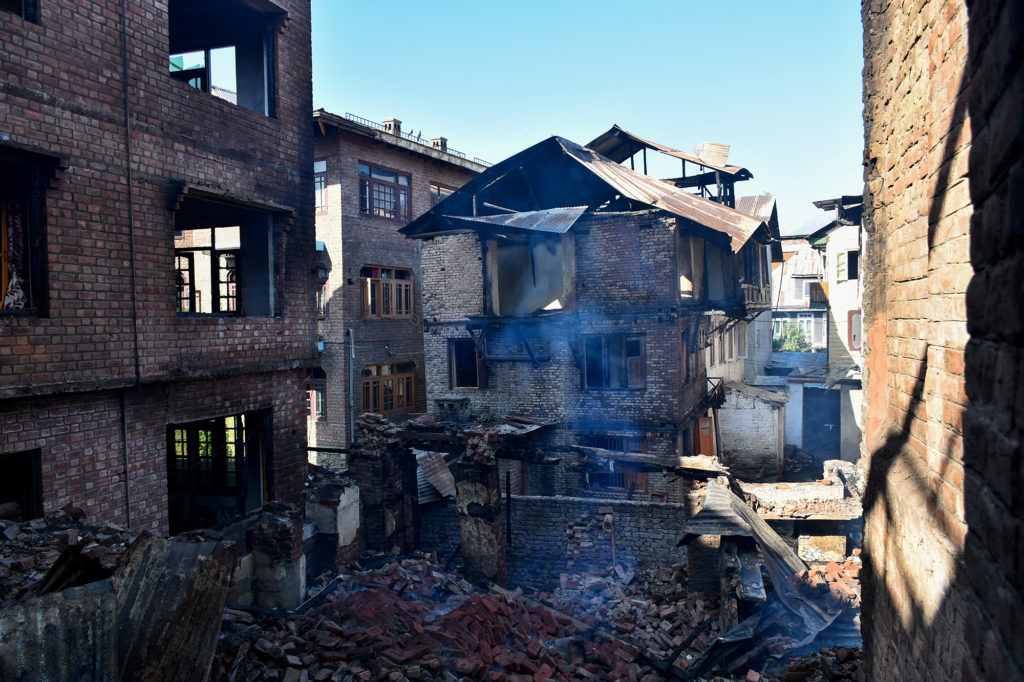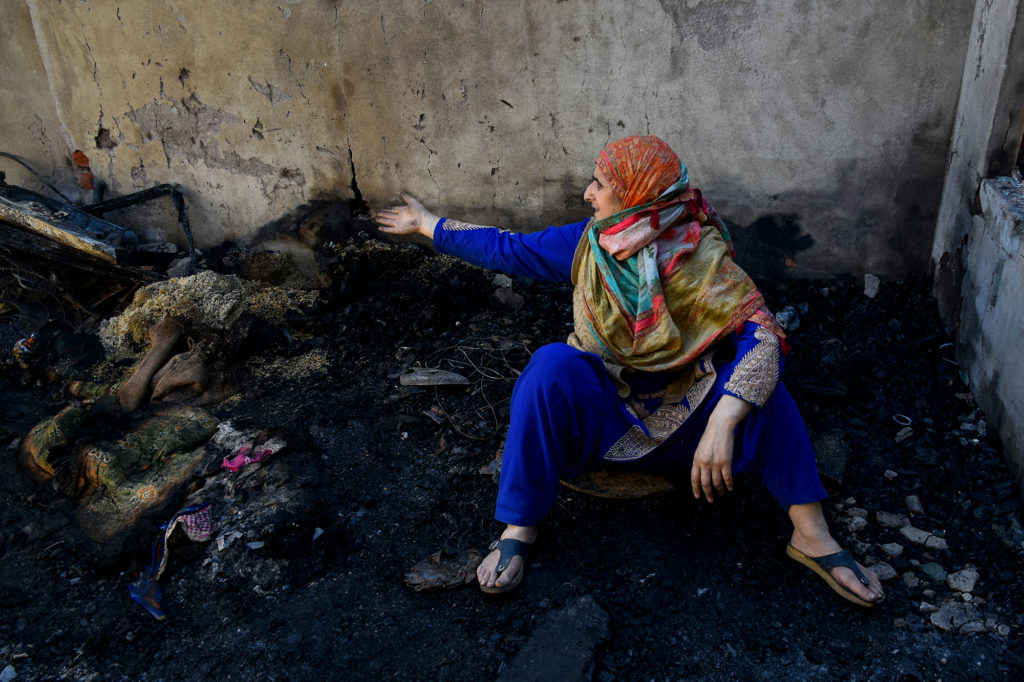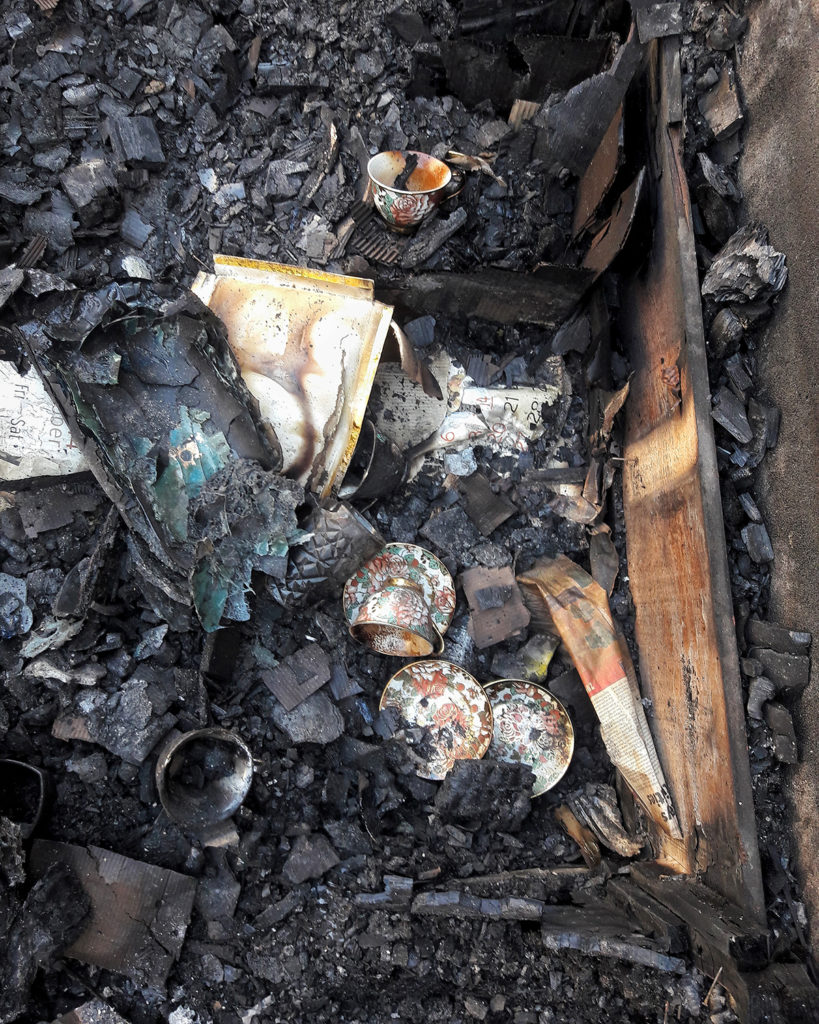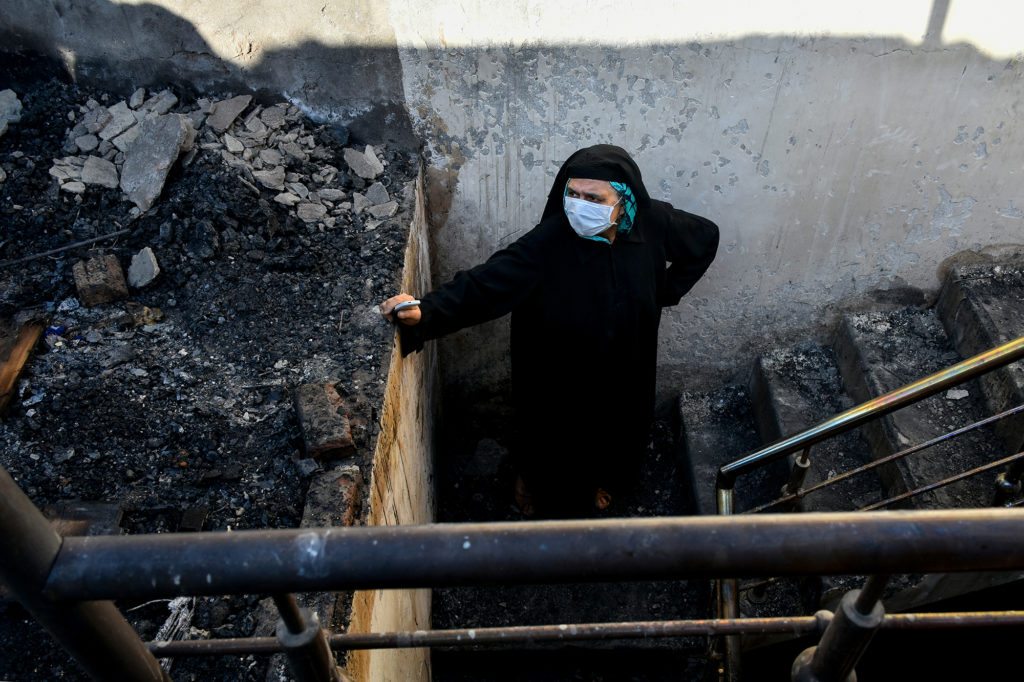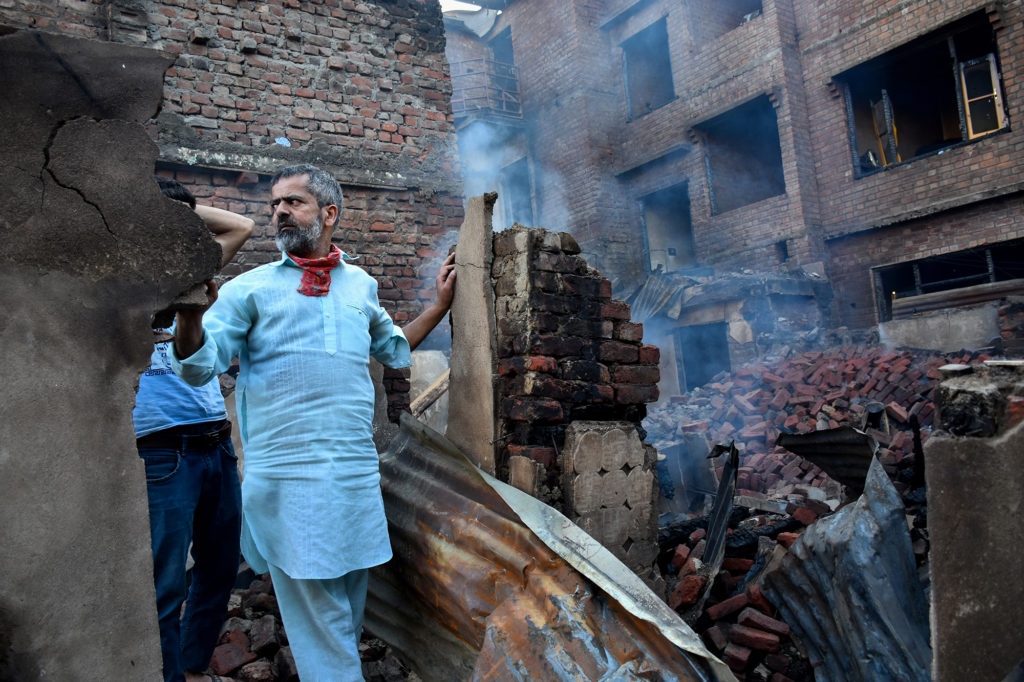It is an understatement that the notions of home for the Indian elite, the home-quarantined middle class, the activists under fabricated cases in jails, the migrant workers on the road and the Kashmiris suffering the state oppression for decades are not the same. The Indian state has been systematically denying the Kashmiris every right to claiming a space as their home. For them, their homes are not private sanctoriums but sites of assault. Writes Tarak Mehta. Photography – Bilal Ahmad.
In our post-COVID 19 world, homes have acquired a unique value. Facebook memes tell us, “Stay the Fuck at Home.” Leaving home in any Indian city in the recent times, during the lockdown, might have caused a middle-class Indian a police-blow or two, even if one has left home to buy the essentials. Meanwhile, millions of migrant workers, were turned out of their temporary homes by their employers, humiliated in the streets by the police because they were trying to walk back to their “homes,” often situated in rural hamlets, the names of which cannot be found in the maps of the nation. Prime Minister Narendra Modi ordered the citizens to light torches from the respective balconies of their homes, completely obliterating the fact that most people in India do not have homes with balconies to begin with. Whether we want it or not, the very idea of home has become a political category like never before.
To think of home as a political category is tricky. In much of liberal thought, “home” has been defined as the abode of peace, the venerated private sphere, the sanctuary. Home is the space where one retires from a day of hard labour in the public world. The home, it has been assumed, because it is removed from the public world of statecraft and economy, represents an individual’s innermost and purest core. Marxist and feminist activists and writers have, almost from the moment of the inception of such schools of thought, have attempted to dispel the notion of home as a “sanctuary.” They have often argued, home is tied to one’s affiliation with a family. Family is what ensures our inheritance of property. Home is property. Property is inextricably tied to the idea of class. Home ownership, therefore, invariably brings up the notion of class identity. In other words, homes exist within a complex political continuum.
Notions about homes are also gendered. Homes are supposed to be the “natural” place for women. Not only are they supposed to be the “natural” place for women, they are also supposed to be the place where women feel most comfortable. Feminist scholars and activists have long pointed out, such a notion of home, disregards the very reality that homes, after all, are political and politicized spaces. Homes are made into “abodes of peace and love” through the labour of women and servants. Such forms of labour have often been termed as “reproductive labour”, as against the “productive labour”, that happens in the public realm. Feminist scholars and activists also contend that there is no naturalized relationship between “women” and “home.” Not only is there no naturalized relationship between “women” and “home”, “homes” also happen to be the spaces within which women and children are violated, abused, made into objects of domestic and sexual violence. Home, then, is hardly the “safe space” that is often imagined within liberal thought.
In fact, a closer look at the idea of “home”, would reveal, there is nothing that is “private” or “personal” about the material realities of a home as such. Citizens of most nations have to pay taxes for the possession of homes. States register the existence of our homes through its myriad processes. A state can designate certain areas as “protected” and therefore prevent individual citizens from building homes in such spaces. In other words, the very notion that homes are “private sanctoriums”, is a rhetorical device, often employed by the liberal state, which falls flat on closer examination.
Yet, middle-class homes – not to speak of elite homes – are by and large “private” spaces. In other words, there is a word hanging in the air here. When we speak of homes as “abodes of peace”, what our political unconscious is really implying, is that, bourgeois homes are privatized sanctuaries. No one thinks of a bustee-shack in an urban tenement as a sanctuary of any kind. No one thinks of a small peasant’s kachha house in a far-off village as an abode of peace of any kind. Nor are the lives of the residents of such homes – including the women – especially private. The state can barge in inside those homes without much consternation, and it does so routinely. Police violence in poorer neighbourhoods, remains a reality in most nations around the world, including in India.
In the same way, the homes of those whom the states consider to be ideologically “dangerous”, are often raided, irrespective of their class or caste identities. In the recent history of the nation, the extensive raids conducted by the Indian state in the homes of those accused in the Bhima Koregaon case – including the octogenarian Telegu poet Varvara Rao, his sons-in-law journalist KV Kurmanath and professor K. Satyanarayan – come to mind. The fact that all of them are middle-class “professionals”, did not matter to the state.
There is then no real private sphere then anywhere within the understanding of a liberal state. The very idea of a “private sphere” is publicly and politically constructed, reinforced and kept alive through intricate patterns of state-capital nexus.
There are moments in the history of a state when this construction of an individual’s home as a “private” space comes under severe crisis. There are places where the pretense of this construction of the individual’s home as a “private sanctuary” cannot be kept up. Within the boundaries of the Indian nation-state, Kashmir happens to be such a place. In fact, in Kashmir, the military occupation is kept alive through reinforcing the crisis. Consequently, violation of the homes and the domestic interiors constitute a routinized strategy of the militarization of Kashmir. In fact, if as Paul Gilroy had commented, slavery is capitalism with its “clothes off”, if anyone wants to see the Indian state in its historic nakedness, one will have to go to Kashmir. It is also the space where historically, the liberal-democratic Indian state of the mainland, has always manifested itself as a fascist state to the Kashmiri citizens.
This nakedness has been written by Kashmiri writers in many forms. And, not surprisingly, such accounts also often offer a critical look at the idea of “home” – a Kashmiri home – as it becomes an object of state violence. For example, Uzma Falak, the poet and anthropologist writes,
Talashi! All the men were taken out except for my grandfather who didn’t keep well and couldn’t move. My grandmother made him lie on the bed and tucked him in, like a child.
They barged in all at once, a swarm. They didn’t take off their boots. I was standing in the corridor, stealing glances. My mother always seemed fearless; at least she pretended to be. She had to pretend. She took all the keys and began opening every room, every cupboard and every box. All the doors were open. The coziness of our residence was laid bare. My chambers of secrecy held no treasures now. There was no “home.”
As they searched each room, every cupboard, each shelf, pushed aside every curtain, lifted off the flooring, this thought would scurry around my mind like a rat, and my heart would pound unusually hard: what if they found what they were searching for? In some corner, on some shelf, in some dog-eared, torn page of a book, in some utensil, under some carpet, behind some door. I would worry about my own self: can they read my mind? Do they scrutinize hearts as well?
I was following the trail of the jackboots when my mother stopped them from entering a room which sheltered the Quran. She explained to a trooper that they couldn’t go with their boots on.
If the liberal state stands upon the creation of a “bourgeois interior”, through the creation of a “separate” private sphere, it is precisely that sense of “privacy” that is being attacked here. The private space can be ripped open at any moment in Kashmir, the state can walk into a citizen’s private interior, without any respect for the decorum that often guide sub-continental norms of polite behaviour. The troopers walking inside Falak’s home without taking off their shoes, is a case in point.
Falak’s essay provides multiple markers of her own middle-class status – in the books that she names, in the object-world that she creates and refers to throughout the essay. Yet, in this narrative of Kashmir’s militarization, the story of class ascendancy, and its attendant privileges and prestige, often take a backseat.
And, this is what an occupation does. The story of the indigenous bourgeois under an occupation, is almost always a story of incomplete bourgeoisfication. Amongst other things, this incompleteness is reinforced – again and again – by the occupying state by launching assaults within the middle-class “private” homes. Which becomes, in many ways, an assault on the very notion of property – Kashmiri property. That hallowed economic, political, social and cultural category upon which is predicated the core essence of a liberal-bourgeois selfhood. In attempting to destroy the class identity of the occupied, what the Indian state does often, is to create a narrative and materialities of a subjectivity that is only Kashmiri, who also happens to be eminently “killable,” as Kashmiri scholars such as Ather Zia have pointed out time and again.
But, in Kashmir, house-raids are not the only forms of assault that the Indian state mounts upon the Kashmiri domestic interiority. In fact, in the scale of repression that militarization has instituted in Kashmir, the house-raids are comparatively “mild.” The “house”, where the raid is being conducted, at least has not been razed to the ground, as also had been the practice of the military for the last 30 years in Kashmir. Destruction of homes, let’s be clear about it, is one of the strategies of war that the Indian state employs in Kashmir routinely, a fact that has come into view of “mainland” India recently with the destruction of homes in Srinagar in the Nawakadal area last month.
On May 19, 2020, in order to kill two Hizbul Mujahideen militants, the security forces destroyed about a dozen homes of the ordinary citizens in the Nawakadal area. The homes were duly evacuated, and when the residents came back, the very structures were gone. What were left, were the remnants, the detritus of what once were their homes.
Without any doubt, the sheer magnitude of this destruction overwhelms us.
And, we have to concede, as we stare at this destruction, that there is an aesthetics to this act. An aesthetics that is wrapped up with both the legalities and the illegalities of the Indian presence in Kashmir. An aesthetics that is not only predicated upon rendering formless what once possessed a form, but an aesthetics that is predicated upon obliteration. The aesthetics of obliteration which also happens to be the language of toxic hyper-masculinity, which demands perpetual subservience and submission.
In fact, hyper-masculinity remains the essential language of imperialism, which almost always wants to shape the world in its own image, according to its own desires. In destroying the homes of the Kashmiri citizens, then, the Indian state performs a kind of hysterical hyper-masculinity. A hysterical hyper-masculinity that is also meant to frighten, a hysterical hyper-masculinity that is also meant to create a general environment of terror within the Kashmiri society at large.
But, to stop there, would be to under-estimate the deep political implications of the politics that underlie the Indian state’s project of destruction of homes in Kashmir. What one needs to understand, the destruction of the homes is an assault on the very idea of an autonomous Kashmiri nationalism.
Nationalisms, as any socio-political analysis would reveal, often times, have constructed the homes as spaces where the “purest” form of a nation’s culture is lived, preserved and sustained. Of course, in some ways, this very construction is gendered. There is often a tacit equalization between “homes” and “women” in nationalist thoughts. Homes are supposed to be the “idealized” and ideal spaces for women’s belonging, on the one hand. On the other hand, both homes and women become repositories of the “deepest” spirit of national culture.
Consequently, when a home is attacked by an occupying state, there is almost a symbolic state-performance of rape. The insertion and penetration of the state in places where it is not welcome. Just as the sexual violence in conflict zones on women is supposed to play a symbolic role in mounting an attack on the community itself, an attack on the homes, often plays a similar role of mounting an attack on what is imagined to be the intimate, the innermost core of a nation and a culture. The Indian state’s destruction of the civilian homes in Kashmir, therefore, also arrive with a symbolic political burden. It is also an attack on the very existence of autonomous Kashmiri politico-cultural desires and aspirations.
Yet, in spite of all such abstract historical and social constructions, a home is a material space. A lived space where the inhabitants continue to create life-sustaining practices. Where they labour and love. Where they fight and argue, develop irreconcilable differences with one another. Homes reveal very different kinds of histories than the ones produced through the more event-ridden public sphere.
As is revealed in photo-journalist Bilal Ahmed’s photographs of the burnt homes. What catches our attention in these snapshots are the domestic objects – books, children’s exercise books, tea-cups, aluminium pots, saucepans with tea-leaves still soaked in them. All affected by the fire, some charred, and barely holding onto their erstwhile shapes. And, all of them testifying to “mundane” lives lived inside these homes – through mundane objects. “Mundane” lives, yet essential in every way. “Mundane”, yet revealing the everyday labours of ordinary people, especially women and children.
When a home is destroyed, it is such private histories and archives, that are also destroyed. When a state destroys homes as an integral part of its counter-insurgency strategies, it does so with an explicit aim to destroy such private histories and archives. What such destruction, then, comes to signify, is the deliberate destruction of the civil society – the Kashmiri civil-society, so to say. The only reality that remains, then, is the reality constructed and espoused by the hyper-masculine state, that has also authored the decades long military occupation in Kashmir.
As it is, like most things in Kashmir, the destruction of the homes hangs between the Indian state’s notions of both legality and illegality. For example, Section 4 (b) of AFSPA (Armed Forces Special Power Act) states, “In an area that is proclaimed as “disturbed”, an officer of the armed forces has the power to destroy any arms dump, hide-outs, prepared for fortified position or shelter or training camp from which armed attacks are made by the armed volunteers or armed gangs or absconders wanted for any offence.” In his interpretation of the Article, journalist Jaalib Ahmed Bhat writes, “An officer on the field in charge of an anti-military operation usually takes the call on demolishing houses during an encounter. It is done to avoid casualties, as it avoids direct confrontation with the militants. Secondly, this repressive act metes out a collective punishment to the local populace who are seen as abettors and supporters of the militants.” On the other hand, Bhat reminds us in the same essay, in one of its recent decisions, the Supreme Court upheld, “a citizen’s right to own property is not only a constitutional or statutory right, but also a human right.” To anyone interested in even a cursory look, the two tenets, both parts of the Indian legal machinery in equal amounts, also exist in contradistinction to one another. Something that the Kashmiris know, and have been forced to know through the years of militarization.
In other words, Kashmir is precisely that place where the purported liberal-democracy of the Indian state is in perpetual crisis, in perpetual contradiction.
As the videos and photographs of families whose homes have been destroyed in Srinagar begin to circulate in social media, it becomes obvious that these families are not affluent by any means. As several journalists and commentators have pointed out, in spite of the absence of any definitive estimates, the thousands of homes that have been destroyed in Kashmir, most often belong to not-so affluent agricultural workers. Like everywhere else, the military occupation in Kashmir, too, operates in and through several contradictions. There are times when it trumps class, yet there are times when it is also heavily implicated in class.
Additionally, the Indian state’s attack on the Kashmiri homes precisely during the time of a pandemic, when everyone is being instructed to stay indoors – within their homes – reveals a double-standard. A double-standard that also bespeaks of a long history of the Indian state’s unkept promises and betrayals in Kashmir. Especially in the times of the post-abrogation of Article 370 and 35A, this double-standard assumes a much more symbolic meaning.
Because, it is through a home, after all, that land is claimed. To destroy a home is also to attempt to delegitimize a people’s claim to land, which, in many ways, remains one of the primary projects of the abrogation. Whether it is visible to the naked eyes or not, the very idea of a “home,” thus, has always been a central political category in the theatre of the military occupation in Kashmir. And, continues to be so, putting enormous pressure on the ways in which we think about the interrelationship between “home” and the liberal-democratic state, and its ultimate morphing into a fascist state.
Bilal Ahmad is a freelance multimedia journalist based in Kashmir.
Nandini Dhar is a teacher and writer.

